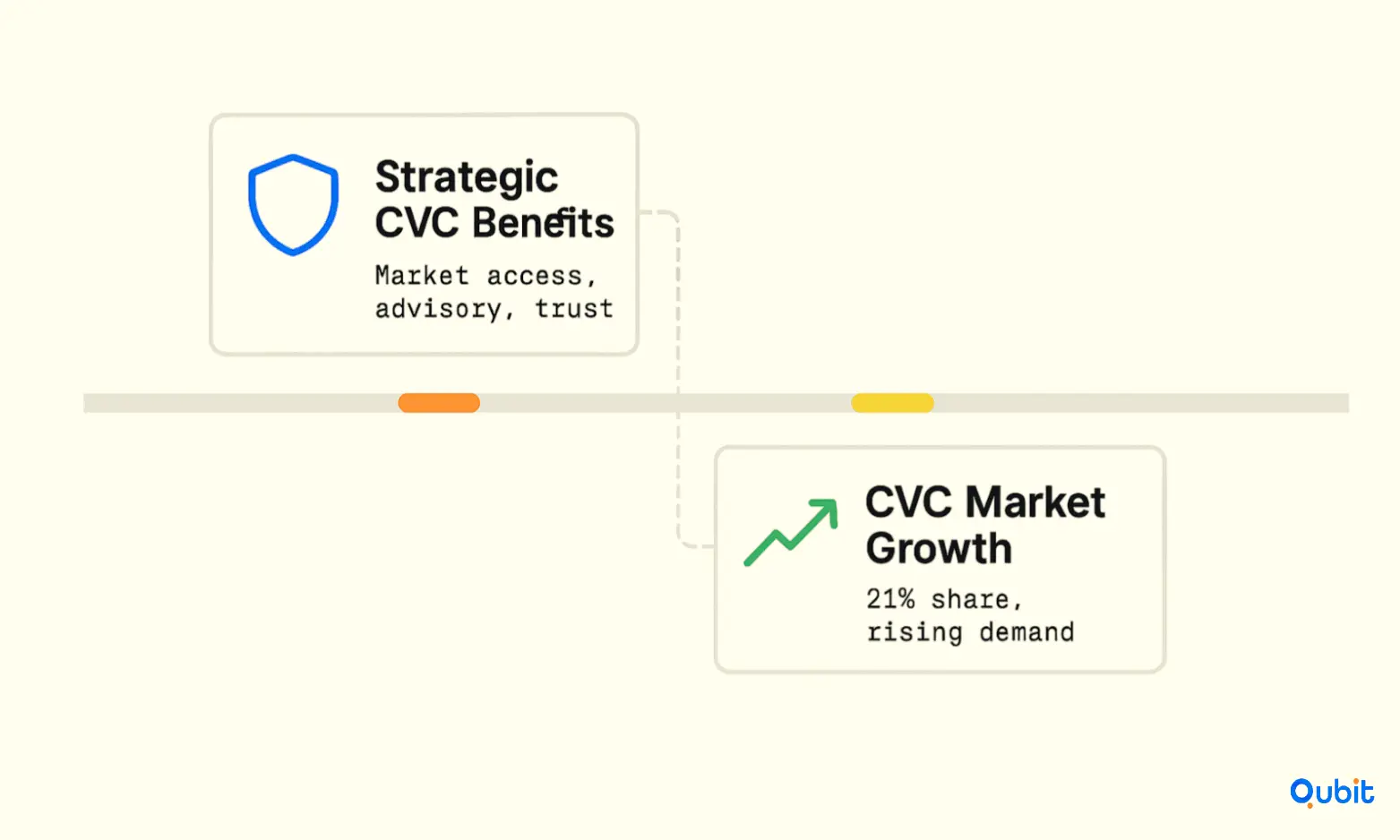The rise of corporate venture capital (CVC) in Identity and Access Management (IAM) is reshaping the cybersecurity landscape. This article explores the dynamics behind this surge, offering insights into investor profiles, market opportunities, and actionable strategies for startups. With an estimated reading time of 7 minutes, readers can expect a concise yet comprehensive overview of the trends driving CVC investments in IAM.
Your exploration of corporate venture capital in IAM connects with insights shared in the cybersecurity startup fundraising guide, which offers a broader industry perspective on fundraising strategies across the cybersecurity landscape.
Let’s jump right in!
IAM Investors and Insights in the US
The Identity and Access Management (IAM) sector in the US has attracted a diverse group of investors, each playing a pivotal role in shaping the industry's trajectory. This section provides a detailed look at the leading investors, highlighting their headquarters, founding years, deal counts, and notable investments. By examining these profiles, we can better understand the market dynamics and the factors driving growth in this space.
| Corporate Objective | What IAM Startups Should Offer |
|---|---|
| Enhance user authentication capabilities | Biometric, passwordless, behavior-based authentication |
| Improve Zero Trust postures | Fine-grained access control, continuous user verification |
| Streamline compliance and governance | IAM policy orchestration, audit automation, flexible RBAC |
| Expand global user access strategies | Decentralized identity, multi-cloud/federated systems |
Startups that can position their solutions to solve one or more of these problems—especially at enterprise scale—stand to gain more than capital. They gain a design partner, sales channel, and market validator, which can be even more valuable in the early-growth stage.
Market Momentum and Future Outlook
The IAM sector is poised for significant growth, with over 500 deals projected in 2024. This forecast highlights the increasing demand for innovative identity solutions and the critical role investors play in driving this momentum. For startups exploring funding opportunities, understanding these investment patterns is crucial.
For those seeking strategies to secure early-stage funding, our analysis finds a natural extension in seed funding passwordless authentication startups, which examines innovative financing options for emerging authentication solutions.
Corporate Innovation Objectives and the IAM Startup Advantage
One of the key drivers behind the rise in CVC investment in IAM is the shift in corporate innovation strategies. Major enterprises are increasingly viewing startups as external R&D engines—an agile extension of their internal innovation programs. IAM startups that can align their capabilities with these priorities are uniquely positioned to receive both investment and strategic support.
What Do Corporates Want from IAM Startups?
While financial return is still important, most CVCs in the IAM and cybersecurity space invest with dual intent: return on investment (ROI) and return on strategy (ROS). This means that startups offering capabilities aligned with a corporate’s near-future product roadmap or internal cybersecurity transformation initiatives can gain priority status.
For those exploring alternative funding methods, your examination of options is enriched by crowdfunding identity protection startups, an article that details community-based funding models for identity-protection ventures. This approach offers a different lens on funding opportunities, complementing your search for traditional IAM investors.
By leveraging advanced tools and exploring diverse funding avenues, you can broaden your network and increase your chances of securing the right investment for your IAM startup.
Cybersecurity Market Trends and Opportunities
The cybersecurity market is experiencing unprecedented growth, fueled by the increasing sophistication of threats such as malware, phishing, and ransomware. As organizations worldwide prioritize digital security, the demand for innovative solutions continues to rise, creating significant opportunities for businesses operating in this space.
Rising Threats and Industry Predictions
The surge in cyberattacks has made cybersecurity a critical focus for enterprises across industries. Threats like ransomware have evolved to target not only financial data but also operational systems, causing widespread disruptions.
AI Integration: A Game-Changer
Artificial intelligence (AI) is revolutionizing the cybersecurity landscape by enabling real-time threat detection and response. AI-powered systems can analyze vast amounts of data to identify anomalies and potential breaches, offering a proactive approach to security. This technological advancement is not only enhancing the efficiency of cybersecurity solutions but also differentiating providers in a competitive market.
Impact on Identity and Access Management (IAM)
The shift toward advanced cybersecurity measures is directly influencing IAM solutions. For instance, the adoption of passwordless authentication is gaining momentum, supported by investor interest and industry trends. This transition aligns with the broader push for seamless and secure user experiences, positioning IAM as a vital component of modern cybersecurity strategies.
As businesses explore these opportunities, understanding financial performance metrics becomes crucial. Resources like arr benchmarks iam startups series a provide valuable insights for IAM ventures seeking to scale their operations and secure funding.
The cybersecurity market’s dynamic evolution presents a wealth of opportunities for innovation and growth. By staying ahead of emerging trends and integrating cutting-edge technologies, businesses can position themselves as leaders in this rapidly expanding sector.
Corporate Venture Capital in Cybersecurity and IAM
Corporate venture capital (CVC) is reshaping how cybersecurity and Identity and Access Management (IAM) startups secure funding. Unlike traditional venture capital, CVC brings more than just financial resources to the table. It offers strategic advantages such as access to new markets, expert advisory support, and the credibility of a well-established corporate brand. These benefits are proving invaluable in an industry where trust and innovation are paramount.

The Strategic Edge of CVC in Cybersecurity and IAM
CVC is not merely a funding mechanism; it’s a strategic partnership. For cybersecurity and IAM startups, aligning with corporate investors can open doors to markets that are otherwise difficult to penetrate. Established corporations often have extensive networks and customer bases, which can provide startups with immediate market access. Additionally, the advisory support from seasoned industry professionals helps these startups refine their strategies, ensuring they remain competitive in a rapidly evolving landscape.
Moreover, the association with a recognized corporate brand enhances the startup’s credibility. This is particularly significant in cybersecurity and IAM, where trust is a critical factor for customer acquisition. A corporate backer signals to potential clients that the startup has been vetted and deemed reliable by an industry leader.
The Rising Influence of CVC
Recent data underscores the growing importance of corporate venture capital in the broader venture funding ecosystem. According to Bain’s 2022 M&A Report, CVC now accounts for 21% of the overall venture market, a significant increase from 11% a decade ago. This upward trend highlights how corporations are increasingly viewing venture investments as a strategic tool for innovation and growth.
The cybersecurity and IAM sectors, in particular, have seen a surge in CVC activity. As cyber threats become more sophisticated, corporations are investing in startups that offer cutting-edge solutions to address these challenges. This trend is not just about financial returns; it’s about staying ahead in a high-stakes industry where innovation is the key to survival.
CVC vs Traditional VC: Strategic Fit Comparison
| Criteria | Traditional VC | Corporate VC (CVC) |
|---|---|---|
| Primary goal | High ROI | Strategic synergies + ROI |
| Involvement in product strategy | Limited | Deep integration and roadmap input |
| Access to customers | Requires founder-driven GTM | Built-in sales channels and ecosystems |
| Exit alignment | IPO or acquisition | M&A, partnership, or ecosystem lead |
| Timeline and patience | Aggressive time-to-scale | Longer timelines, strategic patience |
IAM Startup Readiness: Are You Aligned for CVC Funding?
Before approaching corporate investors, IAM startups need to conduct a self-assessment. CVCs screen opportunities through both a strategic and execution lens. Preparing the following core elements enhances credibility and deal success:
1. Enterprise-Ready Architecture
CVCs are often connected to their parent company’s product, venture, and security teams. IAM startups approaching CVCs from security technology giants (like Cisco, Okta Ventures, Microsoft M12) must show:
- Evidence of enterprise-grade architecture
- Scalability across diverse identity environments
- Security certifications or audits (SOC 2, ISO/IEC 27001)
2. Strategic Roadmap Fit
Startups should study the corporate VC’s published investment theses or recent portfolio activity. Is the CVC focusing on Zero Trust? Are they pushing into Beyond Identity? Your product roadmap must showcase overlap, not divergence.
3. Deployable Pilot Use Cases
Unlike traditional VCs, many CVCs are interested in testing your product internally before investing or scaling. Offering proof-of-value (POV) or sandbox pilots—even before advancing to funding stages—allows corporates to experience product impact firsthand.
Case Studies: IAM Startups Securing Strategic CVC Backing
Case 1: Transmit Security and Citi Ventures
Transmit Security, a leader in customer identity authentication, raised a landmark $543M Series A led by Insight Partners but also included strategic backing from Citi Ventures. Their passwordless CIAM focus aligned with Citigroup’s need to enhance digital onboarding and reduce fraud risk in fintech applications.
Takeaway: Highlighting use cases in finance and building compliance into product design opened doors to massive strategic capital infusion.
Case 2: Beyond Identity and Koch Disruptive Technologies
Beyond Identity raised over $100M backed by Koch Industries. Koch saw value in applying biometric secure authentication not just across its digital platforms, but in modernizing manufacturing floor access amid IoT expansion.
Takeaway: Startups should demonstrate cross-vertical use cases that solve both digital and physical access control challenges to earn broader corporate backing.
Common Pitfalls IAM Startups Make When Navigating CVC
Despite the advantages, not every startup is ready to partner with a corporate venture arm. Here are a few frequently overlooked red flags:
- Too Early in Product Development: CVCs often pass if there’s no production environment or customer feedback.
- Conflicting IP Ownership Issues: Startups must negotiate clear boundaries when working with CVCs from direct competitors.
- Over-Building for One Partner: Tailoring a product too closely to a single enterprise sponsor can limit broader market scalability.
Conclusion
The growing influence of corporate venture capital is reshaping how IAM (Identity and Access Management) ventures secure funding. By aligning with corporate backers, startups gain more than just financial support—they tap into a wealth of market insights, strategic expertise, and access to broader opportunities. This dual advantage not only accelerates growth but also strengthens the foundation for long-term success.
At Qubit Capital, we understand the unique challenges and opportunities in IAM funding. If you're aiming to transform your IAM venture with robust corporate backing, our Fundraising Assistance service is designed to elevate your funding strategy. Let us help you secure the strategic capital you need.
Certainly! Please provide the specific section title, details, and any relevant data or instructions for the section you'd like me to generate.
Key Takeaways
- Corporate VC investment in IAM has nearly doubled, underscoring its strategic importance.
- Top US IAM investors offer comprehensive support from early-stage funding to advanced digital transformation.
- Data-driven tools and reports, such as Bain’s 2022 M&A Report, provide actionable insights.
- Cybersecurity market trends highlight the growing momentum behind passwordless authentication solutions.
- Strategic partnerships with corporate VCs present significant opportunities for IAM startups.
Frequently asked Questions
What is corporate VC investment?
Corporate VC (venture capital) investment is when established companies fund startups to gain strategic insights, technology advantages, or market access. For example, Google Ventures invests in AI and healthcare startups not just for profit but to align with Alphabet’s innovation goals.






